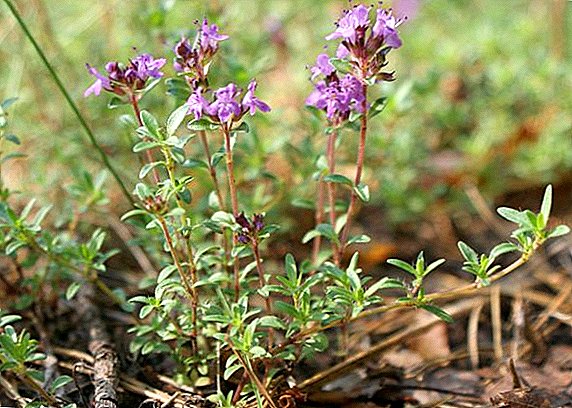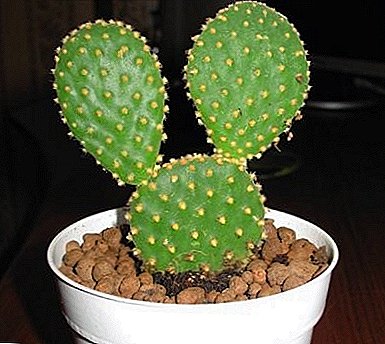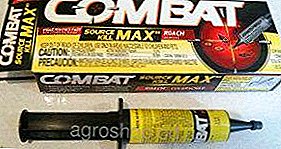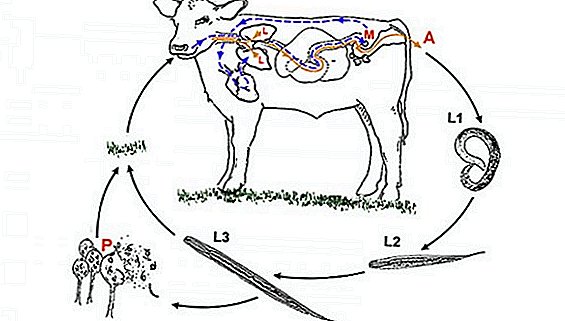 Getting into the human body with cow's milk and meat, worms can not give themselves a long period of time and at the same time destroy the internal organs. Cattle suffer from parasitic neighbors. To avoid the decline of its productivity, as well as mortality and possible health problems, the breeder needs to be aware of the manifestations of vital activity of the most dangerous parasites, methods of infection and treatment. One of the common invasive diseases of cattle is dictyocaulosis, which will be discussed further below.
Getting into the human body with cow's milk and meat, worms can not give themselves a long period of time and at the same time destroy the internal organs. Cattle suffer from parasitic neighbors. To avoid the decline of its productivity, as well as mortality and possible health problems, the breeder needs to be aware of the manifestations of vital activity of the most dangerous parasites, methods of infection and treatment. One of the common invasive diseases of cattle is dictyocaulosis, which will be discussed further below.
What is Dictyocaulosis in Cattle?
This is a helminthic disease of small and large ruminants, caused by parasitic nematodes of the family Dictyocaulidae. Once in the animal's organism, the pathogens are localized in the broncho-tracheal regions, causing their vital activity to retard the growth and development of livestock, the rapid decline in productivity and the loss of livestock. The disease has spread en masse in the northern and central regions of the Eurasian continent, the dictyocaulus larvae manifest themselves less actively in southern latitudes.
Did you know? According to the World Health Organization, every year every second person on the planet becomes infected with one of the three main types of helminths, which leads to enterobiosis (1.2 billion people), hookworm (900 million) and trichocephalosis (up to 700 million).
Causative agent and development cycle
Externally, parasitic nematodes are very inconspicuous. They have a thin filamentary white body with a length of 3 to 15 cm. According to the constitution of their spicules and bursa ribs, veterinarians distinguish several subtypes of larvae:
- Dictyocaulus filaria - more often they infect small herbivorous cattle, are characterized by a body of dina from 8 to 15 cm and a thickness of from 0.35 to 0, 60 mm, have yellow-brown stockings with spicules up to 0.272 mm in length and posterolateral ribs;
- Dictyocaulus viviparus - they are smaller in size, their spicules are characterized by identical sizes, but they do not have the form of a stocking, the larvae at the front end of the body have no button-like formation.
 Life cycle of the larvae of Dictyocaulus viviparus
Life cycle of the larvae of Dictyocaulus viviparusDid you know? In Russia, the incidence of helminth infections is comparable in frequency to the flu epidemic, while in Europe every third person is infected.Under conditions of temperature + 20 ... +27 ° С and air humidity above 55%, parasitic larvae experience a double molt, after which they become invasive. To do this, nematodes need from 3 to 10 days. When the thermometer drops below + 10 ° C or rises above + 30 ° C, dictyocaulus does not develop.
 The life cycle of pathogens continues when they are swallowed by an animal in a pasture or watering place. Finding himself in a favorable environment, parasites again choose the respiratory tract. The part of the worms that remains in the body of an infected cattle, along with blood and lymph, spreads throughout the body. The lungs suffer the most because nematodes infect the bronchi. After a month, the worms become sexually mature, which allows them to produce new generations.
The life cycle of pathogens continues when they are swallowed by an animal in a pasture or watering place. Finding himself in a favorable environment, parasites again choose the respiratory tract. The part of the worms that remains in the body of an infected cattle, along with blood and lymph, spreads throughout the body. The lungs suffer the most because nematodes infect the bronchi. After a month, the worms become sexually mature, which allows them to produce new generations.Sources and routes of infection
In order for the horned ward to become infected with dictyocauline invasion, it is enough to drink it from standing shallow reservoirs, as well as to feed it with grass from wet pastures. The spread of the disease is accompanied by natural rainfall, floods and fungi.
Important! In the course of their vital activity, worms emit special substances - toxoids, which are strong poisons and allergens..It is noticed that the maximum activity of parasitic dictyocauluses begins in the late summer and early autumn. Sometimes a repeated invasive peak occurs in the first half of spring. It is characteristic that there is no mutual infection between small and large ruminants. Helminthic larvae most often infect the young and live in the body of calves for about a year.
 According to experts, the risks of infection are high in the following places:
According to experts, the risks of infection are high in the following places:- river floodplains;
- pastures (especially after dew or rain);
- small rates, lakes and other reservoirs;
- overgrown shrubs (including near the paddock).
Symptoms
Dictyocaulus pathogens on the organism of ruminants have trophic, toxic, inoculatory and mechanical actions, and the migratory larvae of these nematodes are distinguished by antigenic effects. In the affected organs, inflammatory processes progress, as a result of which immunity decreases and secondary infectious infections appear.
Important! The most accurate analysis for all types of worms and parasites is immunofermental, it gives 90% of success, but the diagnosis of helminth infections in feces does not always bring correct results.Recognize the disease can be the following clinical signs:
- depression (arises from the moment of parasite penetration into the mucous membranes of the respiratory tract);
- diarrhea;
- dry, painful cough (manifested in the 3rd and 4th week of the vital activity of worms);
- labored breathing;
- mucous-serous discharge from the nostrils;
- increased body temperature to 40.5-41 degrees;
- exhaustion;
- refusal to eat or poor appetite;
- stationary lying down (usually the sick animal has an elongated neck, ajar mouth and a tongue poured out);
- frothy mouth;
- the hoarseness of the sounds being made.
 Clinical signs of dictyocaulese The danger of cattle dithiocaoleosis is possible complications in the form of:
Clinical signs of dictyocaulese The danger of cattle dithiocaoleosis is possible complications in the form of:
- perevascular bronchitis;
- catarrhal pneumonia (with mild forms of illness);
- diffuse or focal purulent-necrotic bronchopneumonia (severe forms);
- asphyxia;
- catarrhal-purulent pneumonia;
- secondary infections.
Parasites often infect cattle, so you should know how to deal with such parasitic diseases as teliasiosis, babesiosis, actinomycosis, cysticercosis.
Diagnostics
At the slightest suspicion of helminthiasis, veterinarians analyze samples of his excrement according to the Berman-Orlov method in order to find out the true causes of an animal's discomfort. Also, the dictacaulaus larvae can be detected with the help of research using simplified larvoscopic technology.  Experts say that the pathogens will be visible even to the naked eye, if a few drops of a methylene blue aqueous solution are placed on a glass slide. For their review, the drug is shaken and in half a minute light purple tiny larvae appear on the glass surface. Characteristically, other nematodes do not stain.
Experts say that the pathogens will be visible even to the naked eye, if a few drops of a methylene blue aqueous solution are placed on a glass slide. For their review, the drug is shaken and in half a minute light purple tiny larvae appear on the glass surface. Characteristically, other nematodes do not stain.
Did you know? The UN believes that cows do more damage to Earth’s ecology than cars and airplanes are taken together. Such a position is explained by the release of artiodal gases, which together with cow manure are responsible for a third of greenhouse methane. It heats the Earth 20 times faster than carbon dioxide..In the diagnosis of the disease, general symptoms are taken into account. The presence of dictyocaulese is unmistakably indicated by the flow of a nose and an agonizing cough.
In the case when in life to save the cattle failed, an autopsy is carried out. Nematode larvae are visible during examination of the trachea and bronchial alveoli.
Pathological changes
As the parasites settle in the respiratory organs, their bronchi and trachea are more affected by their vital activity. At necropsy of infected cattle, the following metamorphoses in meat carcasses indicate a disease:
 Adult D. viviparous worms in the bronchi of a sick cattle
Adult D. viviparous worms in the bronchi of a sick cattle
- exhaustion;
- anemicity of visible mucous membranes;
- the presence of transudate in the chest and abdominal cavities;
- increased size of the lungs;
- pasty consistency, roughness, "marbling" and pale gray color of the affected areas;
- foamy fluid in the bronchial lumen, in which filamentary parasites live;
- the presence of foci of varying degrees of hepatization;
- atelectasis;
- alveolar emphysema;
- a strong increase in bronchial and lymph nodes;
- hyperemia of the mucous membranes of the trachea and bronchi (sometimes there are signs of hemorrhage);
- mucopurulent plugs in small and medium bronchi;
- bronchiolitis;
- peribronchitis.
Important! In the prevention of dictyocaulosis in cattle, it is of great importance to carry out meadow melioration activities: drainage of marshy and lowland pastures, organization of artificial cultural pastures, improvement of watering sites. Poil wells at the wells should be smooth, without potholes, dry, with solid ground, and the banks of natural water bodies should be solid, with a convenient approach.
Comprehensive treatment
Getting rid of parasitic larvae is not so easy. To do this, the problem population needs to provide proper nutrition and watering, equip a stall in accordance with the veterinary requirements, as well as arrange for the intake of drugs. Consider all the steps in order.
Learn how to get lice from cows.
Conditions of detention
The first thing you need to pay attention to the purity of the crib, which is home to horned wards. In case of infection, experts advise starting therapeutic measures with disinfecting the room and service equipment:
- Animals are temporarily moved to a walking or to another shed, and also all removable objects are carried out.
- After that, litter, manure and feed residues from the feeders are cleaned.
- From the hose under a strong pressure of warm water they wash out the pen, paying particular attention to contaminated sites, crevices and other hard-to-reach places. If necessary, use detergents and brushes.
- When the water in the room dries out (this should occur naturally), the walls and floors are fired using a blowtorch, holding the device for a couple of minutes. The method is relevant for wooden and stone surfaces. Metal structures are treated with chemical disinfectants. Many owners combine roasting with the subsequent treatment with chlorine preparations. After the dry walls, it is desirable to whiten lime, which will help to avoid other infections.
- Do not forget to thoroughly sanitize all feeders and drinkers, as well as shovels, forks.

Did you know? Bulls and cows have become ruminants in the process of evolution. It all started with the fact that these animals could not run fast, they did not have fangs and claws. As a result of these physiological features, the big horned ones were looking for new ways of eating. The most acceptable for them was the swallowing and gradual chewing of the prey in a more peaceful place.In the disinfected dry room, the floor is covered with a 10-cm layer of fresh straw, peat or sawdust. The litter is recommended to be changed every day, removing cow dung. Do not allow horned wards to trample on their own excrement.
 For the health of cows and bulls, it is important that there is a microclimate in the barn:
For the health of cows and bulls, it is important that there is a microclimate in the barn:
- temperature regime - + 5 ... + 15 ° С;
- humidity - 60-70%;
- air exchange - per centner of live weight 17 cu. m / h;
- air circulation rate - 0.5 m / s;
- carbon dioxide concentration - 0.25%, ammonia - 20 mg / cu. m
Proper feeding and watering
Since the nematode dictyocaulese larvae migrate in the grass and prefer a moist environment, farmers must be wary of pastures in the marshy and lowland areas. Gradually grazing on the same territory of cows, goats, and sheep is also extremely undesirable.
Did you know? Worms, getting into the digestive tract, so as not to be digested, secrete special substances - anti-enzymes that protect them.
It is important for animals to provide good nutrition, which will contribute to a strong immunity. In the trough should get only fresh and quality food. Many breeders sow patches of vetch, alfalfa or clover for their horned wards. And in order for the cattle to receive all the necessary vitamins and minerals, they feed it with corn silage, mixed fodders, brewer's grain, bran, fodder mixtures and premixes.
On grazing and in the barn, the animal must always have access to water. It is important that it is clean. And for this you need to regularly wash the drinkers and pour in them a quality product. It is unacceptable that the cow saw out of the puddle.  For the organization of proper nutrition, experienced breeders advise:
For the organization of proper nutrition, experienced breeders advise:
- When the camp keeps cattle in the spring, bring calves to camps that are equipped away from runs, pastures and other places of housing for older groups of animals.
- It is advisable to drive or herd-cell herding system with a periodic change of pasture. In early spring, the plots should be alternated in 10-12 days, and as warming occurs - in 5-6 days, in July - in 3-4 days. Re-grazing on infected areas is allowed only after 2-3 months.
- For grazing it is necessary to use areas of pasture where no infected cattle have been kept since September last year.
- When stall-walking with the onset of spring, the owners transfer the youngsters to the premises isolated from the farm. Near the premises on a dry ground make a yard at the rate of not less than 25 m² per calf. Venture yards should be equipped with sunshades, feeders and drinkers.
Read about common diseases of cows.
Veterinary drugs
Without the use of drugs deworming impossible. You can solve the problem with the following drugs:

- "Loscuran" - represents 40% water solution. For cattle, it is recommended to apply subcutaneously at a dosage of 1.25 ml per 10 kg of body weight, three times on the first, second and fourth day.
- Divezid - aqueous solution for subcutaneous administration. Cows and bulls, the drug is administered with prophylactic and therapeutic purposes in a dose of 1.5 ml per 10 kg of live weight, but not more than 20 ml per animal. Apply twice with daily interval.
- "Ditrazina citrate" - 25% aqueous solution. It is injected subcutaneously with 2 ml of the preparation for every 10 kg of body weight (dry preparation of 0.05 g / kg), three times (on the first, second and fourth day).
- "Aluminum iodide aerosol" - A rare drug that is used for deworming ruminants according to the Loparev method. For this purpose, cows and bulls are kept in an aerosol atmosphere for half an hour. Preventive deworming is carried out twice, curative - three times with an interval of 2-3 days.
- "Diktifug" - 20% water solution. Applied subcutaneously at a dose of 15 mg per 1 kg of calf weight, injected on the 1st, 2nd and 4th day.
Important! After the prophylactic and therapeutic course of antihelmintic intake, veterinarians advise not to let cattle out for grazing for 5 days. In addition, it is important to regularly remove the excreta and carefully dispose of it.
Iodine
This is the most affordable way to deworming. For this purpose, it is required to prepare a highly concentrated aqueous solution of iodine in the following proportions:

- crystalline iodine - 1 g;
- potassium iodide - 1.5 g;
- distilled or boiled water - 1 l.
The finished solution is injected subcutaneously as an injection into the upper part of the trachea. In this case, the cow should lie in the dorsal-lateral position at an angle of 30 °. A day later, a fresh portion of iodine anthelmintic is injected into the opposite side of the neck.
The disadvantage of this method of deworming is extremely time consuming. Therefore, in large farms it is not used.
Prevention
Any disease is easier to prevent than to cure. Therefore, in the case of dictyocaules, timely preventive measures are of particular importance. To this end, experts recommend the following:
- Every trimester to carry out preventive de-worming of cattle with the use of medicinal veterinary drugs. Particular attention should be paid to dysfunctional, exhausted pets.
- Constantly monitor the quality of water and feed, which feeds on cattle. It is important to take measures to improve the diet.
- Timely clean the room, which contains bulls and cows, monitor cleanliness and help improve livestock.
- On grazing take care of the arrangement of watering, as well as to protect pastures from contamination. To this end, effective land improvement activities.
- Conduct a successive change of grazing or free feeding "Fenothiazine."
Important! If symptoms of dictiocaulese are detected, it is necessary to conduct universal deworming, if necessary, repeat it after 10-12 days.Now you know what a helminthic disease of dictyocaulosis is, which is how dangerous for herbivores the dictyocaulus larvae are, how to identify and cure the disease. Preventive measures will help prevent the development of this disease in your household.












